- Parents:
-
Henry Harrison
(1860–1937) -
Alice Barton
(1863–1897) - Half-siblings:
-
Margaret Harrison
(1902–?) -
Nellie Harrison
(1904–1940) -
Joseph Harrison
(1906–?) -
Gladys Harrison
(1909–1909) -
Annie Harrison
(1910–?) -
Thomas Harrison
(1912–?) -
Edward Harrison
(1915–?) -
Elizabeth Harrison
(1918–1998) - Married (July 28th, 1910):
-
Agnes Durie
(1885–1971) - Children:
-
Henry Harold Harrison
(1911–1974) -
John Durie Harrison
(1913–1986) -
Gordon Harrison
(1914–2005) -
Douglas Harrison
(1919–1994) -
Audrey Harrison
(1922–2015)
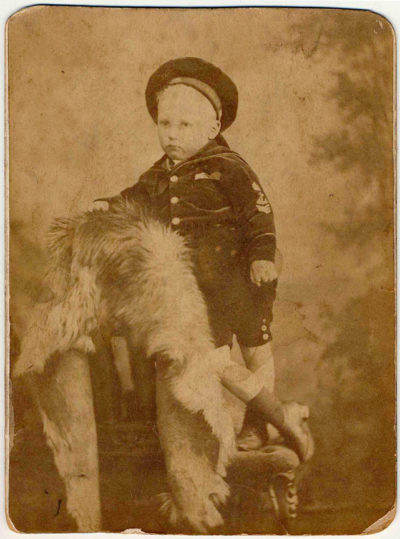
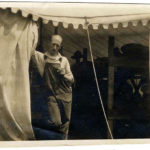
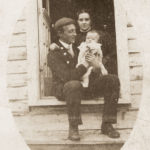


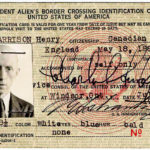
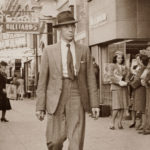

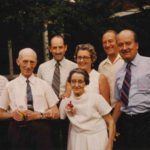
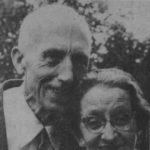
Biography
Henry Harold Harrison (known as Harold) was born in Poolstock, Wigan, Lancaster on 18 May 1886 to Henry Harrison, an engine winder, and his wife Alice Barton. He was their first and only child. The family lived at 20 Walmer Street, an address in the Poolstock neighbourhood that has since disappeared. Sometime between 1886 and 1891, Harold’s father became the proprietor of the nearby Honeysuckle Inn located at 75 Pool Street. The Honeysuckle became the family residence in which Harold grew up, and where he worked in support of the family business.
In addition to his parents, other relatives and inn staff also resided at the Honeysuckle from time to time. According to the 1891 census, his mother’s sisters, Ellen Barton and Annie Barton were living—and most likely working—at the Honeysuckle. His grandparents and many aunts and uncles lived nearby.
Harold recalled working at the Honeysuckle from an early age. He told his daughter of having to stand on a beer keg in order to draw and serve ale at the bar.
Harold’s mother Alice died in 1897 when Harold was age 11; he was her only child. For a period of time, Harold was then cared for by two of his aunts, Nellie Harrison and Elizabeth Harrison, both younger sisters of his father. His father remarried Elizabeth Donahue, a local Poolstock resident, in 1900.
At the time of the 1901 census (3 March 1901), Harold was age 14 living with his father, stepmother, and his father’s cousin, John Harrison, at the Honeysuckle Inn. Harold and John both worked as bar men in the pub. Two teenage girls also lived and worked as domestic servants at the Honeysuckle, suggesting that business was brisk.
On 13 May 1901 just before his 15th birthday, Harold took up a six-year apprenticeship with a local joiner and builder named Robert George Dawson who was a local resident and family friend. The terms and conditions of the apprenticeship were spelled out in an indenture, which is still in the family’s hands today. Under it, Harold received a small wage of 5 shillings per week, increasing over the six-year period to 12 shillings. His first project as an apprentice joiner was to make a coffin. At the outset of his apprenticeship, Harold continued to reside with his father and stepmother, who were beginning to have children together.
We understand from Harold’s daughter that Harold did not get on well with his father, who was a heavy drinker and may have been abusive. To escape the home environment, he moved out of the Honeysuckle when he was about age 16 and lived for a time with his grandfather, Joseph Harrison, who worked as an engineer at the Standish Pumping Station at Boar’s Head. At that time, two of Joseph’s unmarried daughters (Ellen and Margaret) were still in the home, and it is likely that several of Harold’s cousins (Edward and Martha’s orphaned children) also lived there.
When he completed his apprenticeship on his 21st birthday in 1907, Harold emigrated to Canada. He sailed from Liverpool to Quebec aboard the Southwark arriving on August 30, 1907. According to the Southwark passenger list Harold’s intended destination was Montreal. We believe his grandfather, Joseph, paid the passage. He brought to Canada a joiner’s tool chest made of balsa wood and his carpentry tools, some of which are still in the family’s possession. He took up work at mining camps in northern Ontario and Quebec. Between 1907 and 1910, he worked as a carpenter at Porcupine and Cobalt building houses for miners. Harold sent money home regularly from the time he began working in Canada to help support his half-siblings in Wigan. He continued this practice until 1914 when he had a wife and three children of his own to support.
The Harold & Agnes Harrison Family
Sometime in 1907 or 1908, Harold met Agnes Durie, perhaps on the passage to Canada or perhaps after arriving in Montreal. The two were married at Grace Church in Point St. Charles, Montreal, on 28 July 1910. They moved to the Cobalt region of northeast Ontario which was experiencing a silver mining boom. Harold found work there building homes for miners. The 1911 census, taken on April 2, records Harold and Agnes living in Coleman township. Agnes was 7 months pregnant at the time. Harold was working full time as a carpenter at the Temiskaming Mine, about 5 km southeast of Cobalt, earning $400 per year. It is likely he was working in the Pearl Lake/Porcupine area on 11 July 1911 during the great fire, which he (and many others) survived by standing in the lake.
Their first son, Henry Harold (Hank) Harrison Jr., was born in June 1911 in Haileybury (probably the registration district rather than the town). The birth was assisted by a First Nations midwife. In October of that year Agnes and baby Hank sailed to Scotland to introduce the newborn to the family back home. In 1913 Harold, Agnes and Hank moved to Toronto where they lived in a house at 210 Hamilton Street. Might’s Toronto Directories lists Henry H. Harrison, carpenter living at this address from 1913 to 1916. Son John was born at 210 Hamilton Street in April 19013. Son Gord was almost certainly born in this house in 1914. Circa 1917 the family moved to 438 Jones Avenue where they lived for two years.
In about 1918, Harold began constructing a house at 113 Gledhill Avenue in East York. He purchased the lot when a cherry orchard on Gledhill was sub-divided and sold as building lots. 113 Gledhill, with its yard full of cherry trees, became the family home for the next twenty-plus years. Before building the upper floors of the house, Harold built a three-room residence in the basement, which became the family’s home in 1919 while Harold was completing the upper floors. Their son Doug was born in July 1919 in the basement of 113 Gledhill while the house was still under construction. Their daughter Audrey was born in 1922 after the house was completed. Harold was an accomplished cabinet-maker and made much of the furniture for the family home, including two dressers which he signed and which were in the family’s possession as of 2005. The 1921 census enumerated Harold, Agnes, and their four sons living at 113 Gledhill Avenue; Harold gave his occupation as carpenter.
In the mid-1920s, there was a construction boom in Florida, and Harold went there to work for two years. According to his daughter, Harold and his friend Alec Bruce rowed across the Detroit River and entered the US illegally, then hitchhiked to Florida. Harold would write home regularly, corresponding with Agnes and sending money to support the family.
As was the custom at the time, Agnes was a stay-at-home mother raising her family of five children. She was a fastidious housekeeper who would not tolerate a speck of dust anywhere in her home. Every Saturday, two of the boys were made to wash and wax the hardwood floors in the house. The other two boys were assigned to wash and dry the dishes after dinner every night. The children attended Danforth Park public school and East York Collegiate. They all lived at home at 113 Gledhill Avenue until they were married, or in Doug’s case, joined the army.
By the late 1920s, perhaps with money he had saved in Florida, Harold had become a developer/builder, buying land and constructing homes with the intention of selling them. He bought land and built houses on Cranbrook Street and Gledhill Avenue. Unfortunately, the stock market crash of 1929 and the subsequent depression wiped him out financially, and he went back to his old trade, getting jobs where he could.
Harold worked as a joiner on many of the major construction projects in Toronto in the late 1920s and early 1930s. He worked on the construction of the Royal York Hotel in Toronto, which was built between 1928 and 1929. At 28 storeys the Royal York was the largest hotel and the tallest building in the British empire when it was built. He also worked on the Bank of Commerce Building, which was constructed in 1929–1930. At 32 storeys, this surpassed the Royal York Hotel in height and became the tallest building in the British empire for the next thirty years. Harold later worked on the construction of Maple Leaf Gardens, which was built in 1930–1931. The owners of the Gardens ran out of cash during the project and paid the workers in shares, which they had to hawk at bargain basement prices to pay the rent.
The 1931 census enumerated Harold, Agnes and their children living at 113 Gledhill Avenue. Harold was still working as a carpenter building houses, although he had been out of work for 12 weeks during the preceding 12 months. Harold reported his annual salary as $1,700 which equates to $35,000 today. However his older sons were also working so the family income was considerably higher.
When the full impact of the Great Depression hit Toronto, it became impossible to find work. To make ends meet, Harold would make wooden jigsaw puzzles in wooden boxes and sell them to shops on the Danforth. Harold became unable to keep up the mortgage payments on 113 Gledhill Avenue, and lost the property to the mortgage holder, a woman named Nellie Lapp. Nellie refused to evict the family and instead rented them the house for $30 per month. Eventually, his son Hank saved enough money to buy the house back.
Harold eventually found steady work (probably in the late 1930s) with Johns Mansville, a tile manufacturer, where he developed a specialization in building sound-proof rooms for radio and television studios. This job required him to travel to the cities where the projects were located, and he worked in Sackville, Winnipeg, and Edmonton on these projects and probably in the United States as well.
During the 1930s, the family would rent a cottage every summer on Rice Lake. Agnes and her daughter would go up for the summer, and Harold would come up on weekends; the sons would also come up on weekends with their girlfriends.
Harold, or “Pops” as he was known to his family, was a working class man and a socialist through and through. He believed it was unconscionable for some people to be excessively wealthy while others struggled to make ends meet. His one vice was “the ponies,” and he and Agnes frequented Greenwood Racetrack, Thorncliffe Racetrack, and later the new Woodbine track north of Toronto.
In 1950 Harold and Agnes took a trip to England and Scotland by ocean liner to visit relatives—the first time they had been back to the “old country” in many decades. They travelled from New York to Southampton arriving on July 19 and returned from Southampton to Montreal on August 29.
In the mid-1950s, they sold the house at 113 Gledhill Avenue and moved first to Mortimer Avenue and later to 40 Scarborough Beach Boulevard, a home owned by son Hank.
On 28 July 1970, Henry and Agnes celebrated their 60th wedding anniversary. His son John and his wife Norma organized and hosted the event at their home at 40 Wilgar Road in Toronto. About fifty family members participated, including Henry’s sister Aunt Maggie from Wigan who brought the cake, his cousin Doris Darbyshire from Blackpool, and Nan Reekie, Agnes’s niece from Bonnyrigg, Scotland. The event was covered in the local press. Henry and Agnes received congratulations from Prime Minister Pierre Trudeau and a plaque from the Government of Ontario to commemorate the occasion. Here is a photograph of Harold, Agnes and their five children taken during the festivities.
Harold and Agnes lived quietly on Scarborough Beach Boulevard until Agnes died in 1971 after a stroke and a brief stay in the Bluebird nursing home. Harold subsequently moved to the Providence Villa nursing home in East York where he died in 1973. Harold and Agnes were both cremated, and their ashes are interred at St. James Cemetery in Toronto.
Research Notes
The information contained in this biography is based on first-hand and second-hand knowledge of the author as well as discussions with family members who knew Harold personally, including his daughter. It is supplemented by documents handed down by the family as well as UK census records for 1891 and 1901 and civil registration certificates.
Source Documents
- Birth Certificate of Henry Harold Harrison (1886–1973)
- Death Certificate of Henry Harold Harrison (1886–1973)
- Henry Harold Harrison’s and Agnes Durie’s 60th Anniversary, July 1970 (as reported in the Etobicoke community newspaper)
- Indenture of Henry Harold Harrison to Robert George Dawson
- Marriage Certificate of Henry Harold Harrison (1886–1973) and Agnes Durie (1885–1971)
- Government of Ontario Plaque of Harrison’s and Durie’s 60th Anniversary
- Prime Minister’s Telegram of Harrison’s and Durie’s 60th Anniversary
Details
- Burial: St James Cemetery, Toronto;
-
Birth Registration:
1886-06-11, 20 Walmer Street, Poolstock, Wigan, Lancashire;
Harold's mother registered his birth incorrectly.
Although he was named Henry Harold Harrison by his parents, his mother registered his birth as Harold Harrison. He was not aware of this error until he applied for a passport circa 1952.
-
Census:
1891-04-05, Honeysuckle Inn, Poolstock, Wigan;
Harold, age 4, was living at the Honeysuckle with his father, mother, and his mother’s two sisters, Annie and Ellen Barton, both single and evidently employed at the inn.
-
Residence:
1891-04-05, Honeysuckle Inn, Poolstock, Wigan;
Per 1891 Census.
-
Residence:
1897, Poolstock, Wigan;
Frank Manley has noted that Harold was cared for by Nellie and Elizabeth Harrison following his mother’s death in August 1897.
-
Father Remarried:
1900-01-09, St James Church, Poolstock, Wigan;
Henry Harrison married Elizabeth Donahue.
Elizabeth was a spinster, age 26 of 90 Pool Street.
-
Occupation:
1901-03-31, Honeysuckle Inn, Poolstock, Wigan;
Barman.
Per 1901 Census.
-
Census:
1901-03-31, Poolstock, Wigan;
Harold was age 14, living at the Honeysuckle with his father, stepmother, and cousin John. Harold’s stepmother was Elizabeth Donahue.
-
Residence:
1901-03-31, Honeysuckle Inn, Poolstock, Wigan;
Per 1901 Census, Harold was age 14, living with his father and stepmother.
-
Apprenticeship:
1901-05-13, Poolstock, Wigan;
Harold indentured to Robert George Dawson, Joiner.
Robert George Dawson was a local joiner (a skilled worker who makes the wooden structures inside buildings such as doors and windows) having a business on Station Road Wigan.
-
Residence:
1902, Pumping Station, Boars Head, Standish;
Harold went to live with his grandfather, Joseph. Grandfather Joseph Harrison was at this time an engineer employed at the municipal water works at Boar’s Head. He was also the guardian of the orphaned children of Edward and Martha Harrison.
-
Residence:
1904-09-20, 90 Pool Street, Poolstock, Wigan;
Henry & Elizabeth Harrison family home.
Per Nellie Harrison’s Birth Certificate.
-
Residence:
1906-07-30, 90 Pool Street, Poolstock, Wigan;
Henry & Elizabeth Harrison family home.
Per Joseph Harrison’s Birth Certificate.
-
Emigration:
1907 ;
Harold emigrated to Canada.
Harold apparently emigrated to Canada as soon as he completed his apprenticeship at age 21.
- Residence: 1908, 141 Ash Avenue, Montreal, Quebec;
-
Residence:
1918, 113 Gledhill Avenue, Toronto;
Harold commenced building this residence.
-
Occupation:
1925, Florida, USA;
Harold worked in Florida for 2 years.
-
Occupation:
1929, Toronto, Ontario;
Construction Worker.
Harold worked on the construction of the Royal York.
-
Occupation:
1930, Toronto, Ontario;
Construction Worker.
Harold worked on the construction of the Bank of Commerce Building.
-
Occupation:
1931, Toronto, Ontario;
Construction Worker.
Harold worked on the construction of Maple Leaf Gardens.
- Residence: 1960, 40 Scarborough Beach Blvd, Toronto, Ontario;
-
Residence:
1973-11-12, 40 Scarborough Beach Blvd, Toronto;
Per Henry Harold Harrison’s Death Certificate.
Footnotes
A joiner is a woodworker who makes and installs architectural woodwork, mainly in the UK, including things that are called “finish carpentry” and “millwork” in North America. Joiners fabricate and install building components such as doors, windows, stairs, wooden panelling, mouldings, shop cabinets, kitchen cabinets, and other wooden fittings. The skills of a joiner are somewhat intermediate between a carpenter and a cabinet maker.
Robert George Dawson is recorded in the 1901 census as a 30-year-old “joiner and builder for his own account” from Pemberton. He was married with two children. He resided at 18 Poolstock, an address a few blocks from the Honeysuckle Inn. His business is listed in directories of the time on Station Road, which is near the centre of Wigan.
Adjusted for inflation five shillings in 1901 would equate to about £18.00 today, or about $CD 36.00. Assuming Harold worked 60 hours per week as an apprentice his starting wage, in today’s terms, was about 30 pence/hr and his ending wage was about 72 pence/hr.
Some photos and a little quaint history of these buildings may be found at http://www.lostrivers.ca/points/RY&BofC.htm